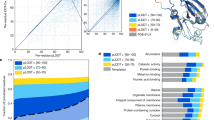Abstract
Discrete models for protein structure prediction embed the protein amino acid sequence into a discrete spatial structure, usually a lattice, where an optimal tertiary structure is predicted on the basis of simple assumptions relating to the hydrophobic–hydrophilic character of amino acids in the sequence and to relevant interactions for free energy minimization. While the prediction problem is known to be NP complete even in the simple setting of Dill’s model with a 2D-lattice, a variety of bio-inspired algorithms for this problem have been proposed in the literature. Immunological algorithms are inspired by the kind of optimization that immune systems perform when identifying and promoting the replication of the most effective antibodies against given antigens. A quick, state-of-the-art survey of discrete models and immunological algorithms for protein structure prediction is presented in this paper, and the main design and performance features of an immunological algorithm for this problem are illustrated in a tutorial fashion.



Similar content being viewed by others
References
Alm E, Baker D (1999) Prediction of protein-folding mechanisms from free-energy landscapes derived from native structures. Proc Natl Acad Sci USA 96(20):11305–11310
Amato NM, Dill KA, Song G (2003) Using motion planning to map protein folding landscapes and analyze folding kinetics of known native structures. J Comput Biol 10(3):239–255
Apaydin MA, Brutlag DL, Guestrin C, Hsu D, Latombe J-C (2002) Stochastic roadmap simulation: an efficient representation and algorithm for analyzing molecular motion. In: Proceedings of the sixth annual international conference on computational molecular biology (RECOMB). ACM, pp 12–21
Burnet FM (1959) The clonal selection theory of acquired immunity. Cambridge University Press, Cambridge
Covell DG (1992) Folding protein α-carbon chains into compact forms by Monte Carlo methods. Proteins 14(4):409–420
Crescenzi P, Goldman D, Papadimitriou C, Piccolboni A, Yannakakis M (1998) On the complexity of protein folding. J Comput Biol 5(3):423–466
Cutello V, Nicosia G (2004) The clonal selection principle for in silico and in vitro computing. In: De Castro LN, Von Zuben FJ (eds) Recent developments in biologically inspired computing. IGI Publishing, Hershey, pp 104–146
Cutello V, Nicosia G, Pavone M (2003) A hybrid immune algorithm with information gain for the graph coloring problem. In: Cantú-Paz E et al (eds) Proceedings of the genetic and evolutionary computation conference (GECCO). Lecture notes in computer science, vol 2723. Springer, Berlin, pp 171–182
Cutello V, Narzisi G, Nicosia G, Pavone M (2005) Clonal selection algorithms: a comparative case study using effective mutation potentials. In: Jacob C, Pilat ML, Bentley PJ, Timmis J (eds) Proceedings of the fourth international conference on artificial immune systems (ICARIS). Lectures notes in computer science, vol 3627. Springer, Berlin, pp 13–28
Cutello V, Nicosia G, Pavone M (2007a) An immune algorithm with stochastic aging and Kullback entropy for the chromatic number problem. J Comb Optim 14(1):9–33
Cutello V, Nicosia G, Pavone M, Timmis J (2007b) An immune algorithm for protein structure prediction on lattice models. IEEE Trans Evol Comput 11(1):101–117
Dasgupta D (ed) (1999) Artificial immune systems and their applications. Springer, Berlin
De Castro LN, Timmis J (2002) Artificial immune systems: a new computational intelligence approach. Springer, London
De Castro LN, Von Zuben FJ (2002) Learning and optimization using the clonal selection principle. IEEE Trans Evol Comput 6(3):239–251
Dill KA (1985) Theory for the folding and stability of globular proteins. Biochemistry 24(6):1501–1509
Dill KA, Chan HS (1997) From Levinthal to pathways to funnels. Nat Struct Biol 4(1):10–19
Dill KA, Bromberg S, Yue K, Fiebig KM, Yee DP, Thomas PD, Chan HS (1995) Principles of protein folding: a perspective from simple exact models. Protein Sci 4:561–602
Hirst JD (1999) The evolutionary landscape of functional model proteins. Protein Eng 12:721–726
Krasnogor N, Hart WE, Smith J, Pelta DA (1999) Protein structure prediction with evolutionary algorithms. In: Banzhaf W et al (eds) Proceedings of the genetic and evolutionary computation conference (GECCO), vol 2. Morgan Kaufmann, San Francisco, pp 1596–1601
Krasnogor N, Blackburne BP, Burke EK, Hirst JD (2002) Multimeme algorithms for protein structure prediction. In: Merelo JJ, Adamidis P, Beyer H-G (eds) Proceedings of the seventh international conference on parallel problem solving from nature (PPSN VII). Lectures notes in computer science, vol 2439. Springer, Berlin, pp 769–778
Lau KF, Dill KA (1989) A lattice statistical mechanics model of the conformational and sequence spaces of proteins. Macromolecules 22:3986–3997
Levitt M (1983) Protein folding by restrained energy minimization and molecular dynamics. J Mol Biol 170:723–764
Manca V (2008) The metabolic algorithm for P systems: principles and applications. Theor Comput Sci 404(1–2):142–155
Manca V (2009) Log-gain principles for metabolic P systems. In: Condon A, Harel D, Kok JN, Salomaa A, Winfree E (eds) Algorithmic bioprocesses. Natural computing series. Springer, Berlin, pp 585–605
Manca V (2010) From P to MP systems. In: Păun G, Pérez-Jiménez MJ, Riscos-Núñez A, Rozenberg G, Salomaa A (eds) Membrane computing. Lectures notes in computer science, vol 5957. Springer, Berlin, pp 74–94
Muñoz V, Eaton WA (1999) A simple model for calculating the kinetics of protein folding from three dimensional structures. Proc Natl Acad Sci USA 96(20):11311–11316
Narzisi G (2008) Optimization and tradeoffs in protein structure prediction. Dissertation, University of Catania
Nicosia G (2004) Immune algorithms for optimization and protein structure prediction. Dissertation, University of Catania
Pavone M (2003) Biologically inspired algorithms for partitioning, coloring and protein structure prediction problems. Dissertation, University of Catania
Toma L, Toma S (1996) Contact interactions method: a new algorithm for protein folding simulations. Protein Sci 5:147–153
Unger R, Moult J (1993) Genetic algorithms for protein folding simulations. J Mol Biol 231(1):75–81
Author information
Authors and Affiliations
Corresponding author
Rights and permissions
About this article
Cite this article
Cutello, V., Morelli, G., Nicosia, G. et al. On discrete models and immunological algorithms for protein structure prediction. Nat Comput 10, 91–102 (2011). https://doi.org/10.1007/s11047-010-9196-y
Published:
Issue Date:
DOI: https://doi.org/10.1007/s11047-010-9196-y




